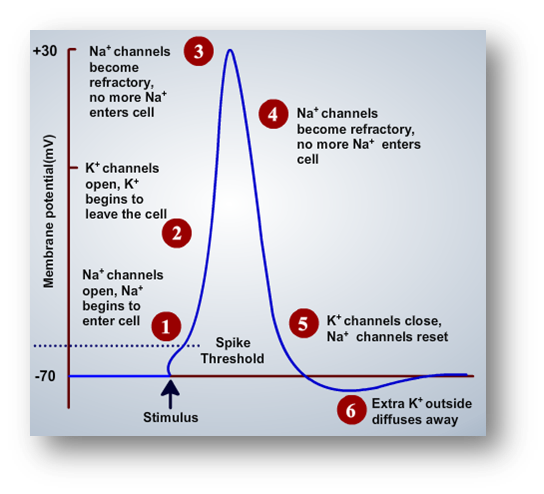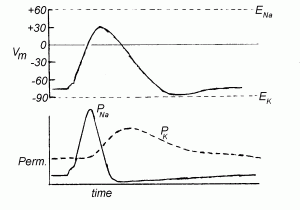Not too long ago we were talking about the resting membrane potential found in every cell of your body. Now it’s time to talk about excitable cells (nerve cells and muscle cells) because thery have the ability to generate an action potential. An action potential, or nerve impulse, is a transient (short lasting) reversal in the membrane potential that is conducted down the length of the fiber. This occurs only in excitable cells: nerve and muscle fibers. If you stimulate a liver cell, that reversal isn’t going to occur.
Reminder of things you should already know for this to make sense (Review Resting Membrane Potential if any of this sounds foreign): We have a high concentration of potassium on the inside of around 150mEq/L. We also have (anionic) proteins in the cell. Since there are more proteins than potassium, we’re going to get a voltage of -90mV on the inside of the cell. Sodium (Na+) on the other hand is mostly outside the cell at a concentration of around 150mEq/L. This difference of more negative ions inside the cell than outside is the resting membrane potential.
Events of the Action Potential
We could stimulate an excitable cell chemically, electrically, or mechanically. If you stick your finger in the power plug, you could stimulate all the nerves in your body electrically. We could mechanically stimulate excitable cells as well because there are neurons that respond to touch and pressure. The most common way this occurs naturally is chemically with chemicals called neurotransmitters.
Remember we have sodium ion channels which are normally closed and sodium can’t get into a cell. They’d like to, but they can’t. However, if you stimulate an excitable cell, these sodium ion channels will briefly open up to allow sodium ions to flow in and reverse the polarity.
1) When we stimulate an excitable cell, Na+ ion channels are going to open up and sodium is going to rush into the cell. Why do the sodium ions want to go into the cell? Because there’s a concentration gradient and there’s also an electrical gradient. Sodium is a positively charged ion (Na+) and so it’s attracted to the negative polarity on the inside. As the positively charged sodium ions flow into the cell, the inside is going to become less negative (depolarized). So instead of -90mV, it’s going to go down to 0 and actually reaches up to +30mV. Right then and there, the ion channels close and now we have a voltage inside the cell that’s now +30mV. The outside is now negative as well. There’s a reason why the inside doesn’t go to +90mV and it’s described in your physiology book if you want to know those details.
2) So how does the cell repolarize back? You would guess the sodium would go right back out, but that’s not what happens. What happens now is that the reversal of the electrical polarity allows causes different potassium channels to open up and potassium molecules to rush out of the cell.
Why do the potassium ions want to rush out of the cell? There’s a concentration gradient (more potassium inside than outside) and also an electrical gradient. Since potassium is a positively charged atom and the inside is now +30mV, it’s going to be repelled and not want to be there. If you’re a positively charged thing, you don’t want to stay inside the positive space because like charges repel.
Ligand-gated Ion Channels and Voltage-gated Ion channels
Now it’s time to introduce two types of ion channels: ligand-gated ion channels and voltage-gated ion channels. There’s actually several different types of ion channels but of course, if you want to learn about them, then read your physiology book. We have to keep things simple to not go crazy.
Ligand-gated channels: Another name for a hormone, neurotransmitter or chemical is a ligand. If a hormone or neurotransmitter or chemical attaches to a receptor site, then it stimulates a ligand-gated ion channel to open. A sodium ion channel is a ligand-gated ion channel. Gated means it’s like a gate that could open and close the ion channels. What opens this a ligand-gated ion channel? A ligand (which is a hormone/neurotransmitter/chemical).
Voltage-gated channels: Didn’t we just say when the inside of the cell becomes positive, different potassium channels open up and rush out of the cell? Yes we did, and it’s not a ligand that caused these to open. There was no change in chemical, but a change in voltage that made these ion channels to open. So those are voltage-gated K+ channels.
3) Repolarization and the Na+/K+ ATP pump: As potassium ions exit the cell, this is going to make the inside of the cell less positive and more negative. This causes a repolarization. Remember the sodium ions that originally rushed in due to the stimulus are still inside the cell. The K+ are not inside the cell because they went out. I want to emphasize that the cell already repolarized. Inside is now -90mV but we have different chemicals: During repolarization there are too many Na+ ions on the inside of the cell and too many K+ on the outside of the cell.
That’s where the sodium-potassium ATP pump comes into the equation. It’s designed to get the potassium ions back in and the sodiums out. This pump is what returns the ion concentrations on the inside of the cell back to the “resting state” and we go right back to the same state that we started with before the stimulation occurred.
So to recap: There is a stimulus, the sodium ions go into the cell causing it to depolarize (become less negative than normal due to the flowing of positive charges in) and then the potassium ions go out of the cell and that repolarizes it back (due to flowing of positive charges out, causing it to be negative). Then we reestablish the ion concentration gradients through the sodium/potassium ATP pump. Simple? Okay let’s look at graphs now so we learn it in another way.
Graphs!
 The graph on the right is showing the membrane potential in millivolts as time (x-axis) passes by. The membrane potential is the voltage of the cell. First we start out at -70mV (remember it varies, it’ s not always -90) and if you look at where the stimulation occurred, the voltage skyrockets from -60 to -50 to -40 to 0 to +30. This is called depolarization (when something becomes less negative; more positive).
The graph on the right is showing the membrane potential in millivolts as time (x-axis) passes by. The membrane potential is the voltage of the cell. First we start out at -70mV (remember it varies, it’ s not always -90) and if you look at where the stimulation occurred, the voltage skyrockets from -60 to -50 to -40 to 0 to +30. This is called depolarization (when something becomes less negative; more positive).
Now notice (#6) as the membrane potential (voltage) repolarizes back to normal, it briefly dips down to be more negative than -70. Why does it become more negative than what we started with? That’s called after-hyperpolarization. This hyperpolarization results from more K+ diffusing out of the cell than number of Na+ that had diffused in. If 100 sodium ions went in but 120 potassium ions went out, then you’re going to be more negative than when you started with. So the cell overshoots and has to recorrect itself.
 On the right we see two graphs this time. The top one is the same thing we just saw, and the bottom one is showing relative changes in membrane permeability. We see the permeability of sodium ions skyrockets and then closes back up very quickly. These positively charged sodium ions are what cause the polarity to switch and then it repolarizes back. What caused the cell to repolarize? That was due to the voltage-gated potassium ion channels opening and K+ flowing out. Notice the permeability of potassium ion channels are never zero (unlike Na+).
On the right we see two graphs this time. The top one is the same thing we just saw, and the bottom one is showing relative changes in membrane permeability. We see the permeability of sodium ions skyrockets and then closes back up very quickly. These positively charged sodium ions are what cause the polarity to switch and then it repolarizes back. What caused the cell to repolarize? That was due to the voltage-gated potassium ion channels opening and K+ flowing out. Notice the permeability of potassium ion channels are never zero (unlike Na+).
This entire thing is what’s known as the action potential. If you care to learn about how your skeletal muscles, cardiac muscles, and visceral smooth muscles work then this is important.
OVERVIEW
1. Depolarization: Membrane potential becomes less polarized than normal
Stimulus ->Increased permeability of sodium ion channels -> Na+ rush into cell -> Depolarization
2. Repolarization: Return of the membrane potential back towards the normal resting state.
Increased permeability of potassium ion channels -> K+ rushes out of the cell -> Repolarization
3. After-hyperpolarization: Membrane potential becomes even more polarized (negative) than normal
Results from more potassium diffusing out of the cell than the sodium that had diffused in.
4. Re-establishment of the Na+ & K+ concentration gradients.
The Na+/K+ ATP pumps use energy to rapidly transport Na+ ions out of the cell and K+ into the cell.
Next we look at what happens after an action potential known as the refractory period…






